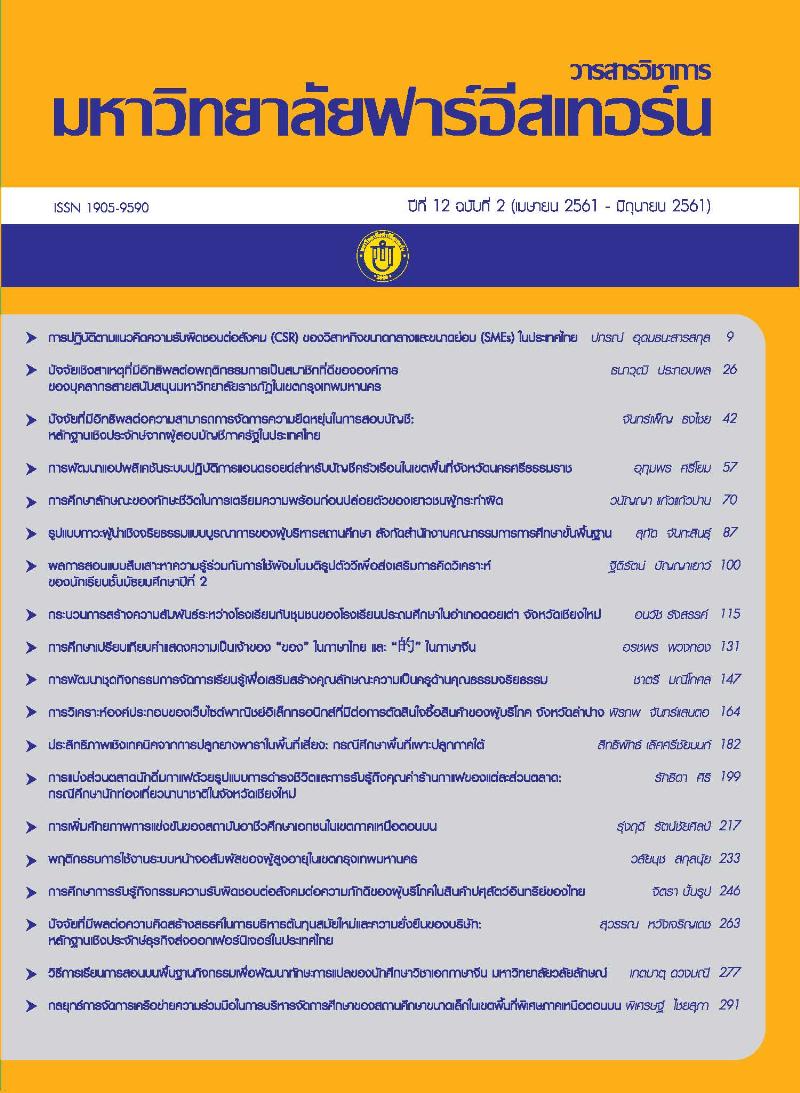Activity-Based Learning Methodwith Developing the Translation Skills of Students Majoring in Chinese at Walailak University
Main Article Content
Abstract
The aim of the research was to study the background and translation aptitudeof 42 studentsmajoring in Chineseat Walailak University whotook the Chinese-Thai Translation I course in the third semester of the 2016 academic yearand to subsequently develop their translation skills. Three types of research tools were used to collect the course-related data: first,a questionnaire; second, teaching plan;and third,identical tests before and after the course to assess their improvement. A descriptive analysis of the data was also carried out.This study showed that the students fell intotwo groups: those who hadabasic knowledge of Chinese, and those who did not. There were three mainsets ofproblems withtheirChinese-Thai translations: language problems; cultural problems; and personal problems. Language problems were the main set of issues facing learners. The main factors affecting the students' ability are the difficulty of Chinese grammar, a lack of cultural knowledge; and not understandingthe culture encoded in the content. The courseinvolved using activity-based learning, whichfocused on learners as a way of involving them fully in teaching activitiesconsisting ofthree types of processing, namely group work,analytical thinking, andpractical activities. It was found that students had improved their translation proficiency andwere interested in working out the appropriate translation by themselves. After completion this course, it was found that students had improved their translation proficiency at a level of significance at of statistical testing.
Article Details
1. Any views and comments in the Journal of Social Innovation and Lifelong Learning are the authors’ views. The editorial staff have not to agree with those views and it is not considered as the editorial’s responsibility.
2. The responsibility of content and draft check of each article belongs to each author. In case, there is any lawsuit about copyright infringement. It is considered as the authors’ sole responsibility.
3. The article copyright belonging to the authors and The Far Eastern University are copyrighted legally. Republication must be received direct permission from the authors and The Far Eastern University in written form.
References
โรงพิมพ์มหาวิทยาลัยธรรมศาสตร์.
ดวงตา สุพล. (2541). ทฤษฎีและกลวิธีการแปล. กรุงเทพฯ : โรงพิมพ์แห่งจุฬาลงกรณ์มหาวิทยาลัย.
ปณชนก ชาญไววิทย์. (2558). การพัฒนาทักษะการแปลภาษาอังกฤษเป็นภาษาไทยโดยใช้แบบฝึกทักษะ
การแปล. วารสารมหาวิทยาลัยราชภัฎเชียงใหม่. 6(2), 1-11.
มาโนช บุญครอบ. (2555). สมรรถนะของผู้เรียนในสถานศึกษาขั้นพื้นฐานตามทรรศนะของผู้บริหาร ครู
และผู้ปกครอง สังกัดพื้นที่เขตการศึกษาสระบุรี. วิทยานิพนธ์ครุศาสตรมหาบัณฑิต คณะครุศาสตร์
มหาวิทยาลัยราชภัฎเทพสตรี.
ฤทัย พานิช. (2559). การจัดการเรียนการสอนภาษาที่สองโดยใช้วิธีการสอนไวยากรณ์- แปล. วารสาร
มนุษยศาสตร์ มหาวิทยาลัยนเรศวร. 13(1), 67-77.
วิจารณ์ พานิช. (2555). วิถีสร้างการเรียนรู้ เพื่อศิษย์ ในศตวรรษที่ 21. กรุงเทพฯ : มูลนิธิสดศรี-สฤษดิ์วงศ์.
ศศิ อินทโกสุม. (2556). รายงานการวิจัยปัญหาการแปลผิดความหมายของนักศึกษาหลักสูตรศิลปศาสตร
มหาบัณฑิต สาขาวิชาการแปลภาษาฝรั่งเศษ-ไทย มหาวิทยาลัยรามคำแหง. กรุงเทพฯ :
มหาวิทยาลัยรามคำแหง.
สำนักงานคณะกรรมการการอุดมศึกษา. (2552). กรอบมาตรฐานคุณวุฒิระดับอุดมศึกษาแห่งชาติ
พ.ศ. 2552. สงขลา : ฝ่ายวิชาการและประกันคุณภาพการศึกษา มหาวิทยาลัยทักษิณ (อัดสำเนา).
สัญฉวี สายบัว. (2545). หลักการแปล : กิจกรรมสู่ความเข้าใจ. กรุงเทพฯ : สำนักพิมพ์มหาวิทยาลัย
ธรรมศาสตร์.
Harden, Th. et al. (2009). Translation in Second Language Learning and Teaching.
Intercultural Studies and Foreign Language Learning. New York : Peter Lang.
Li, J. & Wu, J. (2015). Active learning for discovery and innovation in criminology with
Chinese learning. Innovations in Education & Teaching International. 52(2):
113-124.
Shen, H. & Xu, W.J. (2015). Active Learning: Quantities Inquires into Vocabulary Instruction in Chinese L2 classroom. Foreign Language Annals. 48(1) : 82-99.
Simpson, C. (2017). Language, relationship and skills in mixed-nationality active learning
Classrooms. Studies in Higher Education. 42(4) : 611-622.

